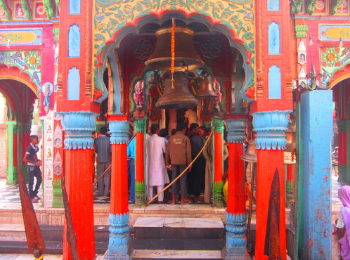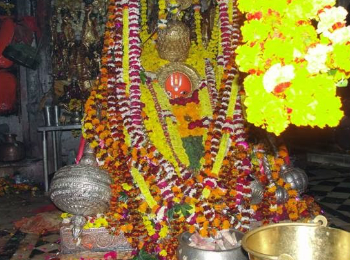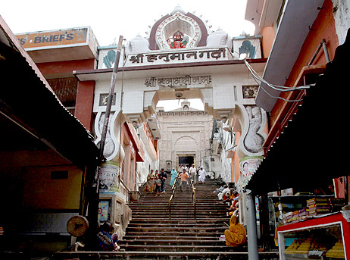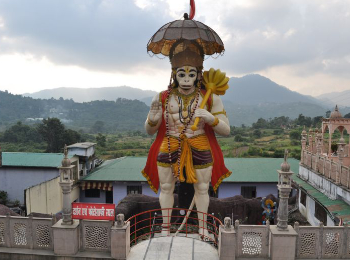- Hanuman
Hanuman Garhi
- Ayodhya,Uttar Pradesh
- View on map
- Tell us about this temple
Overview
Sri Hanuman, the colossal Sri Rama Bhakth, is viewed as the Kotwal (watchman) of Ayodhya city. For long the spot west of Ram Kot (birth spot of Sri Ram) is worshipped as a spot where Sri Hanuman is living and guarding the city of Ayodhya, from that point. Lord Vikramaditya who had resuscitated the city of Ayodhya to its unique radiance and restored the devotees of Sanadhana Dharma, had built a temple for Sri Hanuman.
Amid period when Ayodhya was under the principle of Nawabs of Awadh with Faizabad as their capital, the temple was remade. Amid the time of Nawab Mansoor Aloi a fortress around the temple was manufactured under the supervision of his trusted honorable lieutenant, Sri Tikait Rai.
Ayodhya, arranged in the banks of waterway Sarayu, was the capital of Kaushala Desa and is an antiquated city. The city is of religious significance to all supporters of Sanadhana Dharma. Ayodhya is depicted even in the sacred texts such as Garuda Purana, as one of the seven moksha puris (meaning - the blessed spot for getting liberation).The Ithihasa Epic, Ramayana, portrays the city as the one which was strengthened with watch towers, encompassed with doors and channel. What is of more significance is that the city had long and expansive streets which were cleaned day by day. It will be advantageous for the city managers of today to observe.
The city had been in presence even before the period secured in the epic Ramayana. To the vast majority of us even the depictions of the city found in Ramayana itself is not known appropriately. Specialists are of the feeling that the present day Ayodhya is much littler than the one portrayed in the epic Ramayana by Sri Valmiki. The spot has experienced numerous highs and lows in its history.
Surya Vansi - Sun Dynasty
Capital of Ikshvaku vamsa The city of Ayodhya, which had been known as a city fabricated by Gods and was as prosperous as heaven (described to be so in Atharva Veda) was the capital of the leaders of this extraordinary holy place where there is our own. This blessed spot is the place Sri Rama, child of Dasaratha, was conceived and raised. Valmiki Ramayana gives a full depiction of this city. Like any old place this spot additionally had changed over a timeframe and now, on the first look of it, might seem to have lost all the appeal that was pervasive amid Ramraj. However, in the event that one looks carefully, it is not so much so. It won't be conceivable to understand this, if one visits the city just as a vacationer for a day or two. One ought to embrace a journey for more number of days by staying in the city and undertaking a religious voyage through the same in point of interest. At that point one can see the distinction. The city is dynamic even today with religious intensity. The effortlessness of the general population combined with a genuine and content living by them will have for a striking effect. When you leave this blessed city you can't yet convey with you the influence of this effect for entirely a few days.
Origination of Rama
Sri Rama was conceived, raised, lived and governed from this capital city. Today the royal residence of Dasaratha, where Sri Rama was conceived, is in shambles. It conveys tear to one's eyes to see that the spot of conception amongst the most venerated children of the nation is in such a heartbroken state. The encouragement, on the other hand, is that the royal residence of Sri Rama is fit as a fiddle and is open for guests for most part of the day. This royal residence is presently known as Kanaka Bhawan.
Remarkable among alternate spots of hobby is the castle implied for use by Sri Vibhishana and Sugriva, as going to dignitaries to Ayodhya. This idea was aped by the British rulers who allotted spots in the capital city of Delhi for all the then Rajas (Kings) from various parts of Bharat.
Sri Hanumanji of Ayodhya
Today every one of these spots of interest has ended up spots of worship, on account of the holiness appended to the epic Ramayana, essentially. Every one of these spots of worship in Ayodhya is accepted to be monitored by the immense Sri Ram Bhakth - Sri Hanumanji. Therefore, before undertaking visits to the spots of worship specified above, it is standard to first visit the Temple of Hanumanji as though to look for his earlier consent to visit different holy places.
Hanuman Garhi
Today the temple for Sri Hanuman is known as Hanuman Garhi and is situated in a stronghold arranged at the western entryway of Ram Kot. Hanuman Garhi is really a hollow temple that is receptive by a flight of 76 stages. The way in which this temple has been cut out is stunning. One needs to take the bended flight of stairs to achieve this spot. In the sanctum one can see the divinity of Mata Anjani holding newborn child Hanuman on her lap. At the first look of the divinity, one will be unable to see obviously the points of interest of Mata Anjani and Sri Hanuman.
About the Temple

A murti of Goddess Durga built up by Luv and Kush, children of Sri Ram and Mata Sita, is additionally found in the behind of the fundamental temple.The primary temple is noted for its geometrical configuration and botanical pictures on doors and dividers. Holy people, numbering more than 700, having a place with the Nirwani Akhada dwell in the temple.The most essential celebrations in the temple are Hanuman Jayanti and Choti Diwali.
Adjacent Attractions
As a rule, the temple stays open for the duration of the day for devotees and travellers. Additionally, the locales around the temple offer awesome attractions for vacationers. Subsequent to offering petitions to God, aficionados can set on a trip of going by the acclaimed destinations of Ayodhya.
Arranged in the western piece of Ayodhya, on a lifted area, Ramkot is one the antiquated bastions of the spot. It is likewise one of the significant locales of journey of the city. The festivals of Ram Navami happen with awesome eagerness and draw in a colossal number of explorers and devotees, from different parts of the nation.
At the site of the Ashwamedha Yagna, performed by Lord Rama, stands the antiquated temple; Treta-Ke-Thakur. The development time of this temple goes back to very nearly 300 years when Raja Kullu constructed the temple. Amid 1784, the temple experienced a remodel by Ahilyabai Holkar. Besides, the introductory symbols of the temple were built from dark sandstone.
Tulsi Smarak Bhawan
Another most intriguing destination of the locale is the Tulsi Smarak Bhawan. Built in the consecrated recognition of Goswami Tulsidas, the considerable writer, the landmark offers space for religious sermons, request to God gathering, and reverential projects. Additionally, the landmark likewise houses a performing expressions focus. Aside from that, traveller’s going by the spot can likewise discover Ayodhya Shodh Sansthan, and inundate themselves in the rich gathering of the major scholarly works of Goswami Tulsidas.
By legends, Queen Kaikeyi built a house for her girl in-law Sita Devi, Lord Rama's wife. Known as Kanak Bhawan, the landmark experienced a few rebuilding efforts with the last one in 1891, by Rani Krishnabhanu Kunwari.
Once more, some fanciful adventures express that the development of the Nageshwarnath Temple was by Lord Rama's child, Kush. Aside from its fanciful centrality, the temple has recognized chronicled significance. It is trusted; the temple guided King Vikramaditya in moving the demolished city of Ayodhya.
About the Deity

Pawanputra Hanuman was an incarnation of Lord Shiva and is thought to be a representation of quality, dedication, and steadiness. Master Hanuman was significantly given to Lord Rama.
Main Divinity Of The Temple
The directing divinity of the temple is Lord Hanuman. By prevalent religious convictions, Hanuman Ji showers endowments on the pioneers and enthusiasts and shields them from the real deterrents of life. Also, those with a religious twisted of psyche, visit the spot, to get the gifts of Sankat Mochan. Adherents to the Lord are said to be fruitful in each try of their lives. Additionally, Pavan Putra Hanuman is likewise the imperial gatekeeper of Lord Rama, battling energetically, against the underhanded strengths of Ravana.
Many-Sided Subtle Elements of Icon
Committed gives of Lord Hanuman make it a point to visit the temple each Tuesday and Saturday. Also, the place of worship houses one of the one of a kind icons of the Lord. In this temple, the Hanuman Ji symbol rests in the tender arms of his mom, Shri Anjani Devi. Arranged in the internal sanctorum of the temple, this specific symbol speaks to the newborn child indication of Pavan Putra, meaning the honesty of youth. Around, the tallness of the symbol is 6 inches, decorated with gems and wreaths as offerings.
Legend and Stories

There are a few authentic legends connected with the temple, offering a look at the Hanuman garhi temple history. Legends express that once the Nawab of Awadh was deprived, at the serious affliction of his child. Not able to recuperate him from the seriousness of the disease, the Nawab looked for the perfect gifts of Lord Hanuman. Sankat Mochan showered his gifts on the Nawab's child, and he recuperated from the infirmity. Astonished by the celestial radiance of Hanuman Ji, the Nawab chose to manufacture a temple in his sacrosanct recognition.
Another noteworthy legend connected with the temple expresses that on his arrival to Ayodhya Lord Rama talented this spot to Lord Hanuman. Later the spot got to be mainstream as Hanuman garhi. As Hanuman Ji is the imperial gatekeeper of Lord Rama, Lord Rama longed that enthusiasts offering supplications to God to him will likewise pay their tributes to Sankat Mochan. Hence, Lord Rama's celestial requests express that each devotee and pioneer need to pay their heavenly tributes to Lord Hanuman, before making offerings to Lord Rama.
In the event that some other chronicled legends are to be trusted, then this temple was a last development of a hole. At first, Lord Hanuman lived in a temple, at this specific spot. In addition, legends likewise express this temple to be the gatekeeper of Ayodhya. Sankat Mochan graced the area with his grand vicinity ensured the Janmabhoomi. It is likewise prominent as Ramkot. Aside from that, the religious engravings in the temple express the disallowance on the gathering of expenses, from the offerings made at this religious destination. The engravings are in a Tamrapatra, issued by the Nawab of Awadh.
Temple Timings
04:00 am to 01:00 pm and 03.30 pm to 09:00 pm.
Administration of Hanuman Garhi
At the point when Sri Tikait Rai had remade the temple a course of action for dealing with the temple was made with four organizations of Saints as the trustees. The Chiefs of Haridwari Panti Sect, Basantia Panti Sect, Ujjainaia Panti Sect and Sagaria Panti Sect are the trustees of the temple. These bosses will name a Saint to deal with the temple for a specific period and he will be known as Gaddinas.
Best time to Visit
The temple should be visited on Hanuman Jayanti, the day when Lord Hanuman was born. It is also advised to visit the temple during Ayodhya festivals which is said to attract a large number of devotees every year. This temple is always crowded by a large number of fortune tellers. The devotees of Hanumanji deeply believes that their all wishes will be granted by visiting this temple. This Hanuman idol appeared by itself and is said to be very powerful. They say, the saint who established this temple had meditated in Chitrakut Parvat.
Rare Facts
Ceremonies and Convictions
Aside from the recognized religious essentialness of the temple, it is likewise the conveyor of stupendous structural greatness. Additionally, the temple looks like the structure of a stronghold with round bastisons, arranged at all the four corners. The customs followed in the temple are in finished adherence to the Vedic tenets of worship. Above all, the artist performed at various hours of the day, commend the magnificence of the Lord in full enthusiasm. Firstly, the Mangalarti is performed by the minister, trailed by a Shringar Arti. Sandhya Arti happens at seven o’ clock at night. Utilization of Vermillion in the puja ceremonies is additionally predominant.
Festivity of Merriments
Aside from enthusiasts and travelers paying consistent visits to the temple to pay tributes, the Hanumangarhi temple records the ideal footfall amid unique merriments. The temple has the hallowed festivals of Ram Navami, Dussehra, and Dipawali. By Hindu date-book, the Shukla Paksha, happening on the ninth day of the month of Chaitra, imprints the conception of Lord Rama. Amid this celebration, the temple enclosure resounds with the Akhand Paath, a dominant part of which is taken from Ramacharitamanas. Another noteworthy festival of the temple is Dussehra, which commends the triumphant accomplishment of Lord Rama against the insidious powers of evil spirit ruler Ravana.
Post Dussehra festivities, the temple host Diwali, following a time of twenty days. By the Hindu Lunisolar schedule, Deepawali merriments happen amid the month of Kartikeya, more often than not on the night of the new moon. Explorers and followers from all aspects of the nation, accumulate in colossal numbers to commend the celebrations of the temple, with immense enthusiasm and magnificence.
Paying Journey to Sankat Mochan
In the midst of the sacrosanct spots of journey in Ayodhya, the Hanuman Garhi obtains an extraordinary spot in the hearts of committed devotees. Additionally, the temple offers interesting otherworldly atmosphere for the devotees of Hanuman Ji, for elevating their internal souls. Aside from the merriments of Ram Navami, Diwali and Dussehra, those with exceptional wishes and offerings to Sankat Mochan can offer their regards at any hour of the day, particularly on Tuesdays and Saturdays.
Significance
Blessed Abode Of Sankat Mochan
Amongst the most holy destinations of journey in Uttar Pradesh, Ayodhya bears the rich legacy of being the origin of Lord Rama. The Hanumangarhi Mandir, situated in Sai Nagar, Ayodhya is the blessed home Lord Hanuman. Among the most popular hallowed places of Sankat Mochan in Northern India, one can pay regards to the Hanumangarhi holy place, by climbing 76 stages. By certainties, the area for the development of the temple was a gift by the Nawab of Awadh. Roughly, around the center time of the tenth century, the development of this blessed altar was emerged by Nawab's Hindu subject.
One of a kind social centrality
In light of normal disasters and barbarities of war, a few times, the district of Ayodhya experienced monstrous annihilation, trailed by remaking. In any case, the fanciful sources express that the Hanuman garhi Ayodhya temple withstood the whole impacts of the outrages and till this date, stands tall. In addition, the temple bears the relics of some interesting social practices of the district. Just about around the significant parts of the year, the temple is overwhelmed with crystal gazers from different parts of the locale. Also, the temple enclosure resounds with overpowering yells of pioneers and devotees, paying regards to Hanuman Ji. Aside from that, amid the love of the Lord, an interesting forte; besan laddoos, are offered by the explorers.
Accessibility
Going by the Ayodhya temple is not that extreme, as the temple offers transport practicality from verging on each area of the nation. In addition, the Ayodhya offers clear transportation in all the conceivable mediums. Aside from that, the spot additionally offers unrivaled network through street, rail and air transportation mediums.
Airport
Well, it is apparent that a journey destination of such high stature is certain to pull in countless explorers. Outstation pioneers can achieve the temple through the air terminals of Lucknow and Varanasi, arranged at a separation of 135 and 200 kilometers individually.
Railways
The district likewise offers clear rail transportation offices from Varanasi and Lucknow. Closest rail vault to the temple is the Faizabad train intersection, only 7 kilometers far from the temple. Besides, in the event that you wish to go from Lucknow, it takes three hours, though going from Varanasi takes around four hours.
Road
As far as offering availability through street, the temple offers the best alternatives for pioneers and aficionados taking the street course. As a result of its clear association with Faizabad, arranged at 6 kilometers from Ayodhya, travelers can take the course through that locale. Aside from that, committed gives from Lucknow, situated at 135 kilometers can likewise land at the temple. Likewise to this, committed admirers can take the street courses from Varanasi, Gorakhpur, and Allahabad, which are arranged at a separation of 200, 175 and 165 kilometers individually.
Temple Address
Hanuman Garhi,
Sai Nagar, Ayodhya,
Uttar Pradesh, Pin-224123.
Significance
Devotees visit this temple to seek fulfillment of the following:-
- Happiness
- Removal of worries
- Removal of sins
- Prosperity of future generations
- Relief from suffering
- Suitable grooms for unmarried girls
Shlokas
Raamaaya Ramabadraaya Ramachandraaya Vaydasey Raghunaadaaya Naadaaya Seethaaya Pathaye Namo Namah
Meaning -I offer salutations to Sri Rama, the one who safeguards all, who knows all, who has descended from the Raghu dynasty, Sita's spouse and the Lord of the universe.
Mano Javam , Maruda Thulya Vegam, Jithendriyam Buddhi Matham Varishtam, Vatha Atmajam Vanara Yudha Mukhyam, Sree Rama Dootham Sirasa Namami
Meaning -I bow my head to salute Rama's messenger, who has won over His mind, who is as fast as the wind, who has mastered his organs, who is the most knowledgeable, who is the wind God's son, and who leads as the chief in the army of monkeys.
Anjaneya Madhi Paatalaananam, Kanjanaadri Kamaneeya Vigraham, Paarijatha Tharu Moola Vaasinam, Bhaavayami Bhava mana Nandanam
Meaning -I bow before the wind God's darling son, Anjana's son, the great killer of ogres, who is handsome and like a golden mountain, who lives near Parijatha tree's roots.
Divya Mangala Dehaaya Peethambara Dharayacha Thaptha Kanchana Varnaaya Mangalam Shri Hanumathey
Meaning -Oh Lord Hanuman who has a mystical form, who adorns a silk garment in yellow and who looks similar to molten gold, let thy be auspiciousness.
Timings
04:00 am to 01:00 pm and 03.30 pm to 09:00 pm
